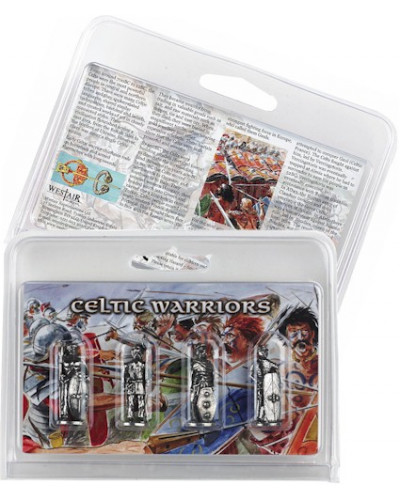Set of 4 Celtic Warriors in Pack
- Product Code: CELT4
- Availability: In Stock
- Pack Qty: 1
Product Description: This set of 4 Celtic Warrior figures, each measuring 4cm tall, are made from lead-free pewter. The four different figures in the pack are of Celtic warriors with different, cloths, weapons and shields. The supplied information card is full colour with an image of the Celts fighting the Romans on the front and has historical information on the reverse, together with additional images. The figures and card are held in a clear clam-shell pack.
Information: From around 700BC to 12BC, the Celts were the most powerful people in central and northern Europe. There were many Celtic tribes and they spoke related languages, shared similar technologies, customs and beliefs, and created works of art in closely connected styles. Their civilisation flourished across a vast area, from the British Isles to the borders of Ukraine. However, there was never a single Celtic nation.
Early Celtic warrior chieftains rode on horseback and armed themselves with long swords. They became wealthy from trading in valuable goods such as salt, and raw materials such as copper, tin and iron ore. When they died, they were buried in magnificent tombs, often wearing gold jewellery and other expensive artefacts. These burials show that the Celts were both powerful and wealthy.
By 550BC, the Celts were building citadels (fortified towns) to dominate the surrounding land. Between the years 400BC to 200BC the Celts moved northwards to Germany and southwards towards Italy. They invaded western Hungary, then headed south into Greece and carved out a kingdom in central Turkey. Celtic people moved into south-western France, Spain and Portugal. This brought them face to face with the Roman army, the strongest fighting force in Europe, who called them Gauls.
For the next 200 years, the Romans and Celts were at war. In 55 to 54BC Julius Caesar attempted to conquer Gaul (Celtic France). The Celts fought against him, led by Vercingetorix. Vercingetorix was eventually trapped at Alesia where he had to surrender to save his people in 52BC. Vercingetorix was eventually executed, in accordance with Roman tradition. In AD42, the Roman army of Claudius invaded and soon overcame the fierce Celtic warriors of Britain. In AD60 there was a major revolt against Roman rule, led by Boudica queen of the Iceni tribe. The revolt failed and Boudica, not wanting to be captured, took her own life by taking poison. By around AD60, Celtic power was almost destroyed with only remote areas such as Scotland, Ireland and Wales surviving with Celtic Traditions.
Tags: Celtic Warriors, Set of 4, Figure, Pack, Pewter, Celtic

